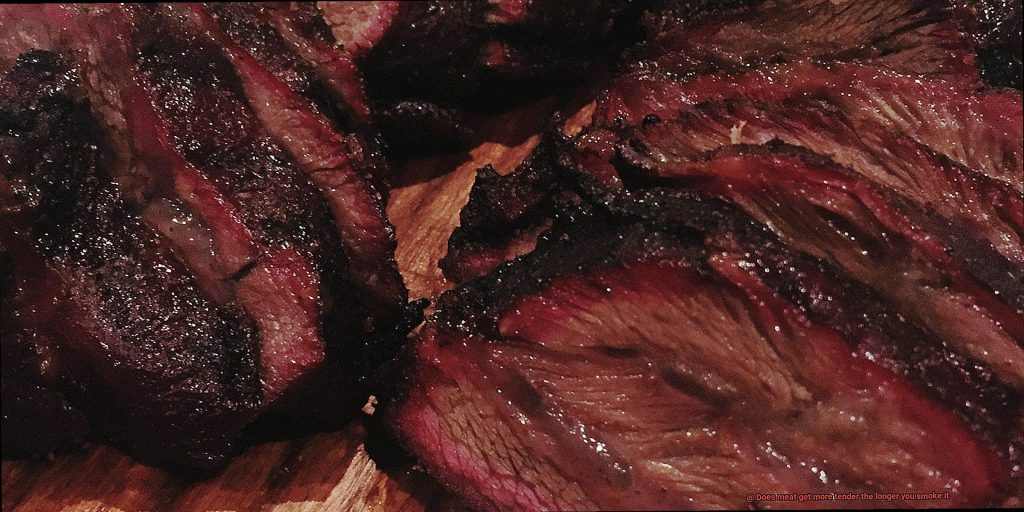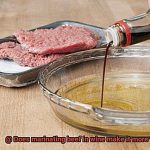Have you ever had a piece of meat so tender it felt like it was melting in your mouth? Or maybe you’ve experienced the opposite – a tough and chewy cut that left you wondering where you went wrong. These experiences often lead to the age-old question: does meat get more tender the longer it’s smoked?
As someone who’s passionate about smoking meat, I’ve always been fascinated by how different cooking methods can impact its texture and tenderness. But the answer to this question isn’t as simple as a yes or no.
In this blog post, we’ll dive deep into the science behind smoking meat. We’ll explore how different smoking techniques and cook times affect the final texture of your meat. And we’ll cover everything from temperature control to proper preparation techniques.
If you’re looking to up your smoking game and achieve perfectly tender smoked meat every time, keep reading. This post is for fellow meat lovers who want to unlock the secrets of achieving that perfect texture.
Contents
Does Smoking Meat Make it More Tender?
Smoking meat is a time-honored cooking technique that has been practiced for centuries. It imparts a unique smoky flavor and aroma to meat, making it a favorite of food enthusiasts worldwide. But the million-dollar question remains: does smoking meat make it more tender? Well, the answer isn’t as straightforward as a simple yes or no. Let’s dive into the details to find out.
Some experts argue that smoking meat does make it more tender. The slow-cooking process breaks down the connective tissue in the meat, resulting in a more tender and juicy product. This is because the low and slow heat used in smoking allows for collagen to break down into gelatin, which lubricates the meat fibers, making them more tender.
However, others contend that while smoking can impart flavor and tenderness to meat, it is not necessarily the smoking process itself that makes the meat tender.
Instead, factors such as the cut of meat, the temperature at which it is cooked, and how long it is allowed to rest after cooking all play important roles in determining the tenderness of the final product. For example, tougher cuts like brisket and pork shoulder benefit from longer smoking times to break down their connective tissue and create a more tender result.
Additionally, thicker cuts of meat require longer cooking times to ensure that they’re cooked all the way through, but overcooking can lead to a dry and tough final product. It’s essential to monitor the internal temperature of the meat using a thermometer to ensure that it’s cooked to perfection.
The smoking method and temperature also impact the tenderness of smoked meat. Low and slow cooking temperatures are crucial for breaking down collagen into gelatin, which helps lubricate the meat fibers and make them more tender.
However, smoking at too high a heat or for too long can cause the meat’s connective tissue to break down too much, resulting in an overcooked and stringy texture. It’s crucial to find the right balance of time and temperature to achieve the perfect level of tenderness.
Lastly, allowing the meat to rest after cooking is essential for ensuring tenderness. Resting allows the juices to redistribute throughout the meat, resulting in a more flavorful and tender final product.
Factors That Affect the Tenderness of Smoked Meat
Smoking meat is an art that requires patience, skill, and understanding of the key factors that affect tenderness. Whether you’re smoking brisket, pork shoulder, or chicken, achieving the perfect tenderness is essential to creating a delicious and memorable dish. In this article, we’ll explore the various factors that impact the tenderness of smoked meat and provide some tips on how to achieve the perfect texture.
Firstly, let’s talk about the cut of meat. The cut you choose plays a crucial role in determining tenderness. Cuts with more connective tissue, such as brisket and pork shoulder, require longer cooking times to break down the collagen and elastin that make them tough. When smoked for an extended period at a low temperature, these tissues break down, resulting in tender, juicy meat.
Secondly, the smoking temperature is a critical factor in determining tenderness. Smoking at a low temperature for a prolonged period can slowly break down connective tissues and result in a more tender outcome. However, smoking at high temperatures can cause the meat to dry out and become tough.
Thirdly, smoking time is another essential factor to consider. Smoking for too long can cause the meat to become dry and overcooked, resulting in a tough texture. On the other hand, smoking for too short a time may not be enough to break down connective tissues entirely, resulting in chewy meat.
Fourthly, resting time is an often-overlooked factor but is just as crucial as the cooking itself. After smoking your meat to perfection, it’s essential to let it rest before slicing it. Resting allows the juices to redistribute throughout the meat and helps prevent it from becoming dry. This resting time also helps improve tenderness by allowing the meat fibers to relax and become more tender.
Lastly, marinades and rubs can significantly affect tenderness. Marinades with acidic ingredients like vinegar or citrus juice can break down connective tissues, resulting in a more tender outcome. Rubs, on the other hand, can add flavor and create a crust on the meat that contributes to its tenderness.
The Right Balance Between Smoking Time and Temperature
Smoking meat is a culinary art that requires a keen understanding of the delicate balance between smoking time and temperature. As an expert in this field, I can tell you that achieving the perfect tenderness in your smoked meats hinges on finding the right balance between these two factors. In this post, I’ll share some of my research notes with you on why this balance is so important and how to achieve it.
It’s important to note that the general rule of thumb for smoking meat is that the longer you smoke a cut of meat, the more tender it will become. However, temperature also plays a significant role in achieving that perfect tenderness. If the temperature is too low, the meat will take longer to cook and may not reach the desired tenderness. On the other hand, if the temperature is too high, the meat may become dry and tough. So, finding that sweet spot between time and temperature is key.
Different cuts of meat require different smoking times and temperatures. For instance, a brisket may need up to 12 hours of smoking at a low temperature to become tender, while a pork shoulder may only need 6-8 hours at a slightly higher temperature. Therefore, it’s essential to monitor both the internal temperature of the meat and the smoker itself to ensure that everything is cooking as it should be.
One tool that can be particularly helpful in achieving the right balance between smoking time and temperature is a digital thermometer. This allows you to check the internal temperature of your meat without having to open the smoker and release heat. You should aim for an internal temperature of around 200°F for most meats.
Another crucial factor when it comes to smoking meat is experimentation. Different cuts of meat, smoking times, and temperatures may require adjustments until you find what works best for you and your smoker. Don’t be afraid to tweak things if needed, and always keep an eye on both the internal temperature of your meat and your smoker itself.
Using a Meat Thermometer to Monitor Internal Temperature
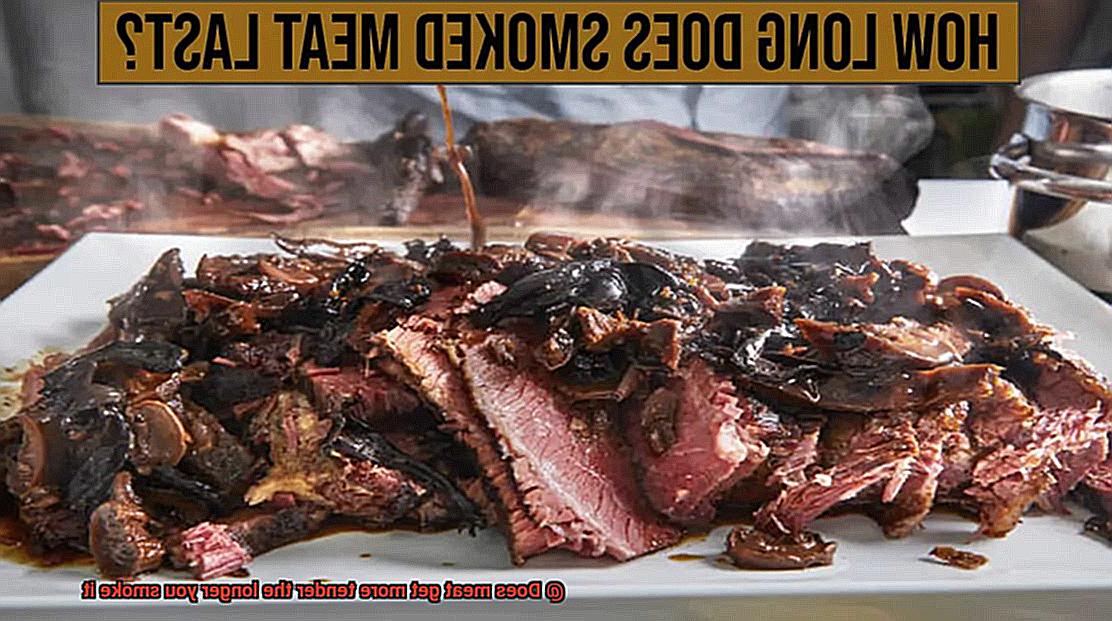
Before you fire up that smoker, let’s talk about the importance of monitoring the internal temperature and how a meat thermometer can help you achieve the perfect smoked meat every time.
First things first, why is internal temperature important? When smoking meat, it needs to reach a certain temperature to become tender and safe to eat. Without proper monitoring, you may end up with tough or even unsafe food. This is where a meat thermometer comes in handy.
Step 1: Choose the Right Thermometer
There are several types of meat thermometers available, but for smoking, you want to use a digital instant-read thermometer. This type of thermometer gives you an accurate reading in just a few seconds, making it perfect for monitoring the internal temperature of your smoked meats.
Step 2: Insert the Thermometer
Take your thermometer and insert it into the thickest part of the meat, making sure not to touch any bones or the smoker itself. You want to get an accurate reading of the meat’s temperature, not the smoker’s temperature.
Step 3: Wait for the Reading
Wait a few seconds until the reading stabilizes. If the temperature is not at the desired level, continue smoking until it reaches the appropriate temperature.
Step 4: Monitor Regularly
Smoking meat can take several hours, so it’s essential to monitor the internal temperature regularly throughout the smoking process. This ensures that you don’t overcook or undercook the meat and end up with tough or unsafe food.
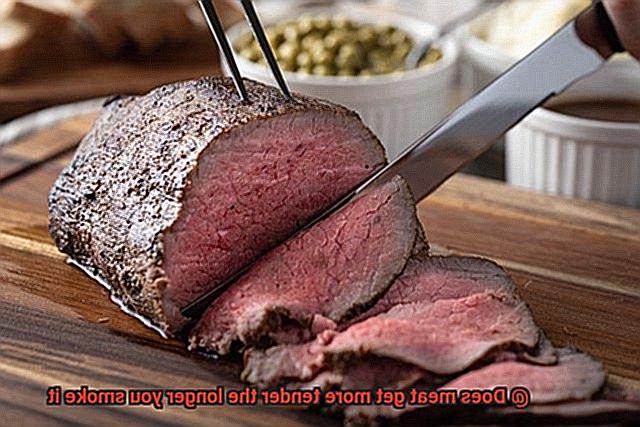
Different cuts of meat require different smoking times and temperatures, so experimentation and careful monitoring are key to mastering this culinary craft. A good rule of thumb is to aim for an internal temperature of at least 145°F for beef, pork, and lamb, and 165°F for poultry.
Different Cuts of Meat Require Different Cooking Temperatures and Times
Look no further than understanding the intricacies of different cooking temperatures and times for various cuts of meat.
Not all cuts of meat are created equal. Each cut has a unique composition of connective tissue, fat content, and muscle fiber structure that affects how it cooks and ultimately tastes. It’s crucial to understand these differences to achieve the best results.
Tough cuts like brisket or pork shoulder require a slow and low cooking method, such as smoking, to break down the collagen and connective tissue. This allows the meat to become tender while still retaining its delectable flavors. On the other hand, tender cuts like filet mignon or ribeye can be grilled quickly at high temperatures to maintain their natural tenderness without sacrificing taste.
However, thickness also plays a significant role in determining cooking times and temperatures. Thicker cuts need longer cooking times and lower temperatures to ensure that the center is cooked through without overcooking the exterior. So keep this in mind when planning your meal.
And don’t forget about the importance of letting your meat rest after cooking. This allows the juices to redistribute throughout the meat, resulting in a more tender and flavorful final product. It’s a small step that makes a big difference.
Tips for Ensuring Your Smoked Meat Comes Out Tender
Smoked meat is a delicacy that requires time, patience, and skill to achieve the perfect tenderness. The following tips will help you ensure that your smoked meat comes out tender and juicy every time.
Choose the right cut of meat
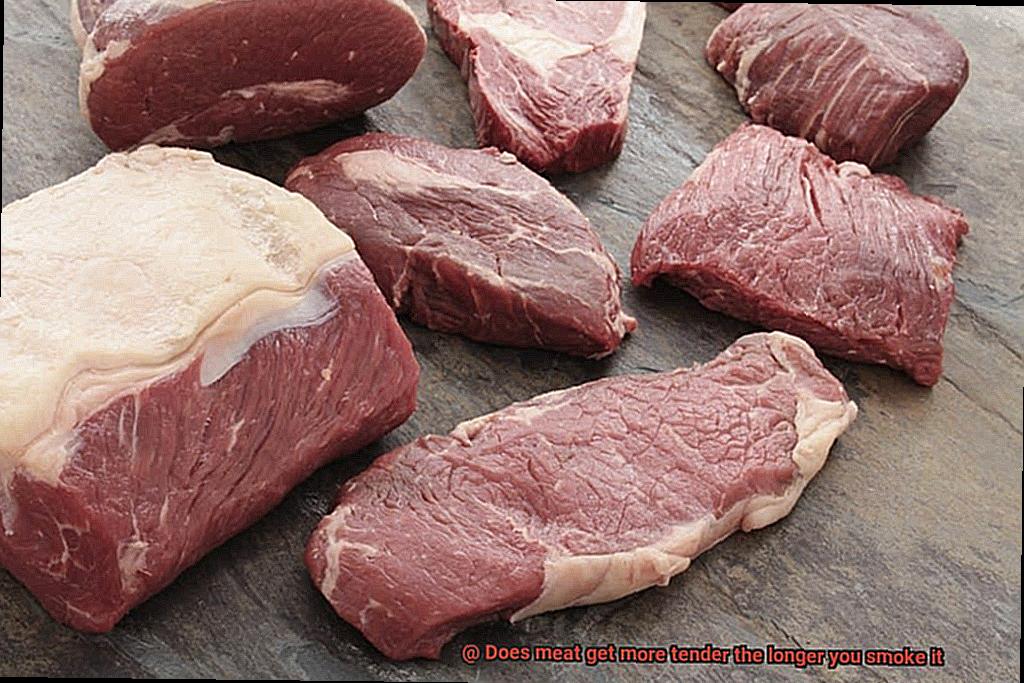
One of the most critical aspects of achieving tender smoked meat is selecting the right cut. Tough cuts, such as brisket or pork shoulder, benefit from low and slow cooking methods like smoking. These cuts have a lot of connective tissue that breaks down during a long smoking process, resulting in tender and flavorful meat. On the other hand, lean cuts like steak or chops can become tough and dry if overcooked on the smoker.
Maintain a consistent temperature
Temperature control is crucial for tender smoked meat. Fluctuations in temperature can cause the meat to cook unevenly, leading to tough and dry patches. Investing in a high-quality smoker that can hold a steady temperature for hours is essential for consistent results.
Monitor internal temperature with a thermometer
Different cuts of meat require different cooking temperatures and times, so it’s crucial to use a digital thermometer to monitor the internal temperature of the meat. For example, brisket should be cooked until it reaches an internal temperature of around 195-203°F for optimal tenderness.
Use high-quality wood and equipment
The type of wood you use for smoking can impact the tenderness and flavor of your meat. Hardwoods like oak or hickory provide consistent heat for even cooking while adding a rich flavor to your meat. Additionally, using a water pan in your smoker can help regulate humidity levels and prevent the meat from drying out.
Allow your meat to rest
Allowing your smoked meat to rest after cooking is essential for retaining its juices and achieving a tender texture. Letting your meat rest for at least 20-30 minutes before slicing allows the juices to redistribute throughout the meat, resulting in a more tender and flavorful end product.
The Danger of Overcooking and Drying Out the Meat
Smoking meat is an art that requires skill, patience, and love. It’s about creating a masterpiece that will tantalize your taste buds and leave you wanting more. However, there is one mistake that many home cooks make when smoking meat; overcooking and drying out the meat. This mistake can be disastrous, ruining all of your hard work.
One of the biggest dangers of overcooking meat is that it can easily dry out. This is especially true for lean cuts of meat like chicken breast or pork loin. When left on the smoker for too long, they lose their moisture, leaving you with tough and chewy meat. It’s like chewing on a piece of leather and definitely not what you want to be serving your guests.
Another danger of overcooking meat is that it can become stringy and fibrous. While this may be desirable in some cuts of meat like brisket or pulled pork, it can be unpleasant for others. Nobody likes to eat stringy and tough chicken or beef, trust me.
So how do you avoid overcooking and drying out your precious meat? First things first, invest in a good quality meat thermometer. Different cuts of meat require different cooking times and temperatures, so it’s important to do your research beforehand. Monitoring the internal temperature of your meat will ensure that you take it off the smoker at the perfect time.
Secondly, consider using a marinade or brine to help keep the meat moist during smoking. A well-made marinade will infuse delicious flavors into the meat while keeping it juicy and succulent.
htaZqsnxAIY” >
Conclusion
In the world of smoking meat, tenderness is king. It’s what separates a mouth-watering masterpiece from a tough and chewy disappointment. While some may argue that smoking meat does indeed make it more tender, others suggest that it’s not just the smoking process itself that imparts tenderness, but rather a combination of factors.
Choosing the right cut of meat is essential to achieving optimal tenderness. A well-marbled cut like brisket or pork shoulder can withstand longer cooking times and higher temperatures without drying out. Maintaining a consistent cooking temperature is also crucial for ensuring that your meat cooks evenly and doesn’t dry out.
But how long should you smoke your meat? That depends on the cut, thickness, and desired level of tenderness. Too short a smoke time can leave your meat tough and undercooked, while too long can result in dryness and overcooking. Finding that sweet spot requires patience and experimentation.
Resting your smoked meat after cooking is also an important step in maximizing tenderness. Allowing the juices to redistribute throughout the meat will result in a more succulent final product.
Of course, even with all these tips and tricks at your disposal, there are still pitfalls to avoid when smoking meat. Overcooking and drying out your precious protein are common dangers that can be easily avoided by using a quality thermometer and incorporating marinades or brines into your preparation.
In conclusion, achieving perfectly tender smoked meats every time requires attention to detail, patience, and a bit of trial-and-error.

